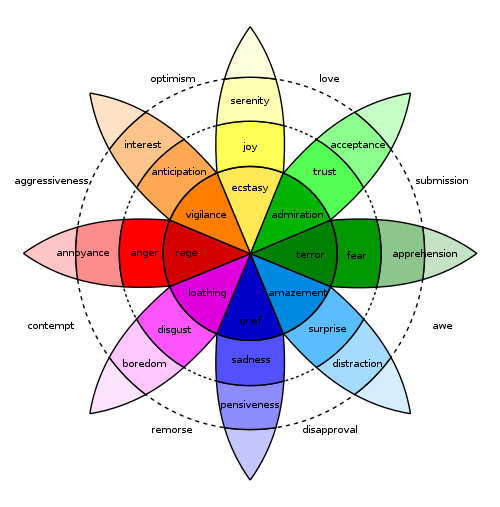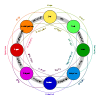Irritability
Irritability is the excitatory ability that living organisms have to respond to changes in their environment. The term is used for both the physiological reaction to stimuli and for the pathological, abnormal or excessive sensitivity to stimuli.[1]
| Look up irritable or ornery in Wiktionary, the free dictionary. |
| Irritability | |
|---|---|
| Specialty | Psychiatry |
When reflecting people's emotions and behavior, distressing or impairing irritability is important from a mental health perspective as a common symptom of concern and predictor of outcomes.[2]
Definition
Irritability is the excitatory ability that living organisms have to respond to changes in their environment.[1] The term is used for both the physiological reaction to stimuli and for the pathological, abnormal or excessive sensitivity to stimuli. Irritability can be demonstrated in behavioral responses to both physiological and behavioral stimuli, including environmental, situational, sociological, and emotional stimuli.
In humans, irritability may be a significant transdiagnostic symptom or disposition that occurs across or at any point during the lifespan.[3] It is commonly defined as the tendency to react to stimuli with the experience of negative affective states (especially anger) and temper outbursts, which may or may not be aggressive.[4][5][6] This definition is well known to have similarities with the definitions of anger and aggression. New hypotheses[6][7] and data-driven research[8] are focused on identifying what is unique to irritability, anger, and aggression. The definition is broad. It is also consistent with special definitions that are relevant to research and treatment. One is that irritability is a low threshold for experiencing frustration.[9] This definition is helpful for experiments because researchers can induce frustration by blocking desired rewards or doling out unexpected punishments. However, it is not particularly specific to irritability, as frustration is its own construct with a number of emotional and behavioral associations.[10][11] A second prominent special definition describes a group of behavioral issues often occurring in those diagnosed with an autism spectrum disorder.[12] This deserves mention here because this version of irritability has been a commonly used in a number of clinical trials and defines the current US Food and Drug Administration irritability indication.
Signs and symptoms
As an emotional and behavioral symptom in humans, someone is considered to be irritable when they have a short temper, become easily frustrated, or feel grouchy or grumpy. Caregivers may report tension in the household or fatigue. They may make accommodations to avoid provoking their dependents. Irritability is associated with a number of mental health conditions.[13] It is a defining characteristic of any mood disorder, such as bipolar, depressive, and disruptive mood dysregulation disorders.[13] It is also a major feature of a number of other disorders, including autism spectrum disorders, traumatic stress disorders, generalized anxiety disorder, etc.[6] Finally, it is a notable characteristic of delirium, dementia, hormonal change, metabolic disturbance, chronic stress, pain, and substance/medication withdrawal. Recently published books by researchers studying and clinicians specializing in irritability are available.[14]
Of course, given that irritability is not specific to any one condition, clinicians consider biological, social, psychological, and familial factors. Irritability may be an indicator of diagnosis, course of illness, or prognosis. For example, a major concern for clinicians is the time course of irritability. If a person presents as uncharacteristically irritable, then a clinician may become concerned a change or episodic illness, such as a neurologic insult or mood disorder. Understanding the time course of irritability is critical for establishing the diagnosis of pediatric bipolar disorder from disruptive mood dysregulation disorder.[15] In another example, chronic, severe irritability in older children (not including young children, e.g. preschool age, where normative irritability may be severe)[16] may predict later depression and anxiety[2] and suicidality.[17][18][19]
Neurophysiology
Currently, there is no known single neurophysiologic basis of irritability. Irritability may be associated with loss of function in a focal area or diffuse damage. It has been associated with dementia, stroke or concussion, neurochemical changes, e.g. serotonin depletion, or hormonal changes, e.g. in postpartum depression.
Several major neural systems have been implicated across a number of studies for idiopathic, chronic irritability.[20] These include the following: 1) prefrontal areas that underlying complex, goal directed behavior, especially inhibitory control and the regulation of emotions; 2) cortico-subcortical systems underlying reward processing, particularly in reaction to a frustrating stimulus; and 3) cortico-subcortical systems underlying threat and arousal processing, particularly in the context of social fairness or social threat.
Treatments
The treatment for irritability targets its underlying cause, such as hyperthyroidism, anemia, or a manic episode.
Irritability may arise as a significantly distressing or impairing symptom that may not simply be addressed by treating the associated condition. The context in which irritability occurs remains an important guide to treatment. For example, temper outbursts may be disruptive and profound in those with an autism spectrum disorder. For these individuals a thorough functional analysis and functional communication training may result in improvement by itself. In addition, the US Food and Drug Administration has approved risperidone and aripiprazole for irritability in the context of autism. Due to the long term adverse effects of these medications, physicians may prescribe agents that may be off-label but are known to be effective.
Critically, there is no single behavioral treatment or medication that is effective for irritability across all conditions.
It is reasonable to adjust lifestyle habits, such as managing sleep, exercise, stress, and diet, should they be contributory.[21]
Related terms
- Anger
- Reactive Aggression
- Annoyance
- Resentment
- Disruptive mood dysregulation disorder
- Oppositional defiant disorder
References
- D, Venes (2013). Taber's Cyclopedic Medical Dictionary. Philadelphia, Pennsylvania: F.A. Davis Company. ISBN 978-0-8036-2977-6.
- Vidal-Ribas, Pablo; Brotman, Melissa A.; Valdivieso, Isabel; Leibenluft, Ellen; Stringaris, Argyris (2016). "The Status of Irritability in Psychiatry: A Conceptual and Quantitative Review". Journal of the American Academy of Child & Adolescent Psychiatry. 55 (7): 556–570. doi:10.1016/j.jaac.2016.04.014. ISSN 0890-8567. PMC 4927461. PMID 27343883.
- Eshel, Neir; Leibenluft, Ellen (2019-12-04). "New Frontiers in Irritability Research—From Cradle to Grave and Bench to Bedside". JAMA Psychiatry. 77 (3): 227. doi:10.1001/jamapsychiatry.2019.3686. PMID 31799997.
- Caprara, G.V.; Cinanni, V.; D'Imperio, G.; Passerini, S.; Renzi, P.; Travaglia, G. (1985). "Indicators of impulsive aggression: Present status of research on irritability and emotional susceptibility scales". Personality and Individual Differences. 6 (6): 665–674. doi:10.1016/0191-8869(85)90077-7. ISSN 0191-8869.
- Holtzman, Susan; O’Connor, Brian P.; Barata, Paula C.; Stewart, Donna E. (2014-05-15). "The Brief Irritability Test (BITe)". Assessment. 22 (1): 101–115. doi:10.1177/1073191114533814. ISSN 1073-1911. PMC 4318695. PMID 24830513.
- Toohey, Michael J.; DiGiuseppe, Raymond (April 2017). "Defining and measuring irritability: Construct clarification and differentiation". Clinical Psychology Review. 53: 93–108. doi:10.1016/j.cpr.2017.01.009. PMID 28284170.
- Beauchaine, Theodore P.; Tackett, Jennifer L. (2020). "Irritability as a Transdiagnostic Vulnerability Trait:Current Issues and Future Directions". Behavior Therapy. 51 (2): 350–364. doi:10.1016/j.beth.2019.10.009. ISSN 0005-7894. PMID 32138943.
- Bettencourt, B. Ann; Talley, Amelia; Benjamin, Arlin James; Valentine, Jeffrey (2006). "Personality and aggressive behavior under provoking and neutral conditions: A meta-analytic review". Psychological Bulletin. 132 (5): 751–777. doi:10.1037/0033-2909.132.5.751. ISSN 1939-1455. PMID 16910753.
- Malhi, Gin; Bell, Erica; Outhred, Tim (2019-06-27). "Getting irritable about irritability?". Evidence Based Mental Health. 22 (3): 93–94. doi:10.1136/ebmental-2019-300101. ISSN 1362-0347. PMID 31248977.
- Berkowitz, Leonard (1989). "Frustration-aggression hypothesis: Examination and reformulation". Psychological Bulletin. 106 (1): 59–73. doi:10.1037/0033-2909.106.1.59. ISSN 1939-1455. PMID 2667009.
- "NIMH » Construct: Frustrative Nonreward". www.nimh.nih.gov. Retrieved 2020-04-10.
- Kaat, Aaron J.; Lecavalier, Luc; Aman, Michael G. (2013-10-29). "Validity of the Aberrant Behavior Checklist in Children with Autism Spectrum Disorder". Journal of Autism and Developmental Disorders. 44 (5): 1103–1116. doi:10.1007/s10803-013-1970-0. ISSN 0162-3257. PMID 24165702.
- Diagnostic and statistical manual of mental disorders : DSM-5. American Psychiatric Association., American Psychiatric Association. DSM-5 Task Force. (5th ed.). Arlington, VA: American Psychiatric Association. 2013. ISBN 978-0-89042-554-1. OCLC 830807378.CS1 maint: others (link)
- Stringaris, Argyris. Disruptive mood : irritability in children and adolescents. Taylor, Eric. Oxford. ISBN 978-0-19-166205-8. OCLC 905544004.
- Towbin, Kenneth; Axelson, David; Leibenluft, Ellen; Birmaher, Boris (2013). "Differentiating Bipolar Disorder–Not Otherwise Specified and Severe Mood Dysregulation". Journal of the American Academy of Child & Adolescent Psychiatry. 52 (5): 466–481. doi:10.1016/j.jaac.2013.02.006. ISSN 0890-8567. PMC 3697010. PMID 23622848.
- Wiggins, Jillian Lee; Mitchell, Colter; Stringaris, Argyris; Leibenluft, Ellen (2014). "Developmental Trajectories of Irritability and Bidirectional Associations With Maternal Depression". Journal of the American Academy of Child & Adolescent Psychiatry. 53 (11): 1191–1205.e4. doi:10.1016/j.jaac.2014.08.005. ISSN 0890-8567. PMC 4254549. PMID 25440309.
- Pickles, A.; Aglan, A.; Collishaw, S.; Messer, J.; Rutter, M.; Maughan, B. (2009-11-26). "Predictors of suicidality across the life span: The Isle of Wight study" (PDF). Psychological Medicine. 40 (9): 1453–1466. doi:10.1017/s0033291709991905. ISSN 0033-2917. PMID 19939326.
- Conner, Kenneth R.; Meldrum, Sean; Wieczorek, William F.; Duberstein, Paul R.; Welte, John W. (2004). "The Association of Irritability and Impulsivity with Suicidal Ideation Among 15- to 20-year-old Males". Suicide and Life-Threatening Behavior. 34 (4): 363–373. doi:10.1521/suli.34.4.363.53745. ISSN 0363-0234. PMID 15585458.
- Brezo, J.; Paris, J.; Turecki, G. (2006). "Personality traits as correlates of suicidal ideation, suicide attempts, and suicide completions: a systematic review". Acta Psychiatrica Scandinavica. 113 (3): 180–206. doi:10.1111/j.1600-0447.2005.00702.x. ISSN 0001-690X. PMID 16466403.
- Brotman, Melissa A.; Kircanski, Katharina; Stringaris, Argyris; Pine, Daniel S.; Leibenluft, Ellen (2017). "Irritability in Youths: A Translational Model". American Journal of Psychiatry. 174 (6): 520–532. doi:10.1176/appi.ajp.2016.16070839. ISSN 0002-953X. PMID 28103715.
- "Irritable mood: Causes, Symptoms and Diagnosis". www.healthline.com. Retrieved 2018-05-04.
External links
| Classification | |
|---|---|
| External resources |

